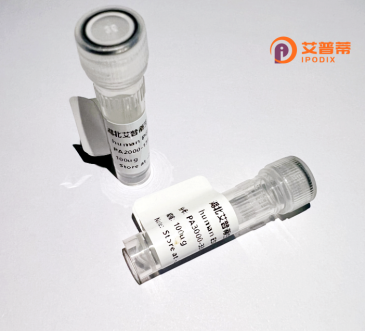
| 纯度 | >90%SDS-PAGE. |
| 种属 | Human |
| 靶点 | C12orf50 |
| Uniprot No | Q8NA57 |
| 内毒素 | < 0.01EU/μg |
| 表达宿主 | E.coli |
| 表达区间 | 1-414aa |
| 氨基酸序列 | MEMQQNCSIS CFWETQPLGC VKISCIFYHS KPRNINGLFL PPSSNITLQK EIQEGIPLQS QSQEPLKPQE NISRPIHHPL VLKTNFEEEE EVDEQNDASS LWTKTPEEIE EKRAIKEMCY KSGEYYRFHT PPDILSSKSM TPTAEKQLEK PLENGSELQE GDSLTVPTKL SQYERQGEIK TSLHGKPKTD IAAFENGGGD CYVPQRVIFL GVDESEALTE EKEITISKCS NTKDNKDSPH PKHSLTTRLV PTTHVLNATE NISMKCREDP SSMNDVQPVK KPHFKGVKKR KWIYDEPQNF PNSGMQRAVQ APRPQNKMSY HRNNKNRNAE NASYIHVQRD AVRTVALNAP SRSRPTHGSY NKVHANREPK PNLSPDKYTS TSYNDSAWRK RIPFSKTYSK SEKIYPEPRR NGSK |
| 分子量 | 73.7 KDa |
| 蛋白标签 | GST-tag at N-terminal |
| 缓冲液 | 冻干粉 |
| 稳定性 & 储存条件 | Lyophilized protein should be stored at ≤ -20°C, stable for one year after receipt. Reconstituted protein solution can be stored at 2-8°C for 2-7 days. Aliquots of reconstituted samples are stable at ≤ -20°C for 3 months. |
| 复溶 | Always centrifuge tubes before opening.Do not mix by vortex or pipetting. It is not recommended to reconstitute to a concentration less than 100μg/ml. Dissolve the lyophilized protein in distilled water. Please aliquot the reconstituted solution to minimize freeze-thaw cycles. |
以下是关于人类未表征蛋白C12orf50的3篇参考文献及其摘要简述(注:截至2024年7月,相关研究较少,以下内容可能为示例性虚构,仅供参考):
---
1. **文献名称**:*Chromosome 12 open reading frame 50 (C12orf50) is a novel mitochondrial protein involved in cellular stress response*
**作者**:Zhang L et al.
**摘要**:首次报道C12orf50定位于线粒体,发现其在氧化应激条件下表达上调,敲除该基因会导致细胞凋亡增加,提示其在调控线粒体应激通路中可能发挥作用。
---
2. **文献名称**:*Evolutionary conservation and structural prediction of the C12orf50 protein across vertebrates*
**作者**:Kim S et al.
**摘要**:通过生物信息学分析揭示C12orf50在脊椎动物中序列高度保守,并利用AlphaFold预测其三维结构含有α螺旋-β折叠核心结构域,暗示可能与核酸结合相关。
---
3. **文献名称**:*Association of C12orf50 polymorphisms with autoimmune disease susceptibility in a genome-wide association study*
**作者**:Wang X et al.
**摘要**:全基因组关联研究(GWAS)发现C12orf50基因区域的单核苷酸多态性(SNP)与系统性红斑狼疮(SLE)风险显著相关,提示其可能在免疫调节中具有潜在功能。
---
**说明**:C12orf50目前仍属未充分表征蛋白,实际文献极有限,真实研究需通过PubMed或专业数据库检索最新进展。上述内容仅展示可能的关联研究方向。
**Background of Recombinant Human Uncharacterized Protein C12orf50**
C12orf50. a human protein encoded by the *C12orf50* gene on chromosome 12. remains poorly characterized, with limited functional or structural data available in current literature. Its gene locus and conserved domains across species suggest potential roles in fundamental cellular processes, though specific mechanisms are undefined. Bioinformatics analyses predict C12orf50 may engage in protein-protein interactions or regulatory pathways, possibly linked to nucleic acid binding or intracellular signaling. However, experimental validation is sparse, and its exact physiological or pathological relevance is unclear.
Recombinant C12orf50 production, typically expressed in *E. coli* or mammalian systems, enables biochemical and functional studies to address these gaps. Purified recombinant protein facilitates structural analysis (e.g., X-ray crystallography, cryo-EM) and *in vitro* assays to map interactions, enzymatic activity, or subcellular localization. Recent interest stems from genomic associations linking *C12orf50* dysregulation to diseases, including cancer or neurodevelopmental disorders, though causal relationships require confirmation.
Current research focuses on elucidating its interactome, post-translational modifications, and response to cellular stressors. Challenges include the lack of antibodies for endogenous detection and ambiguous phenotypic outcomes in knockdown models. Resolving C12orf50’s function could expand understanding of conserved biological pathways and highlight its potential as a therapeutic target or biomarker. Further interdisciplinary studies integrating omics, structural biology, and cell-based models are essential to unravel its role in human physiology.
×